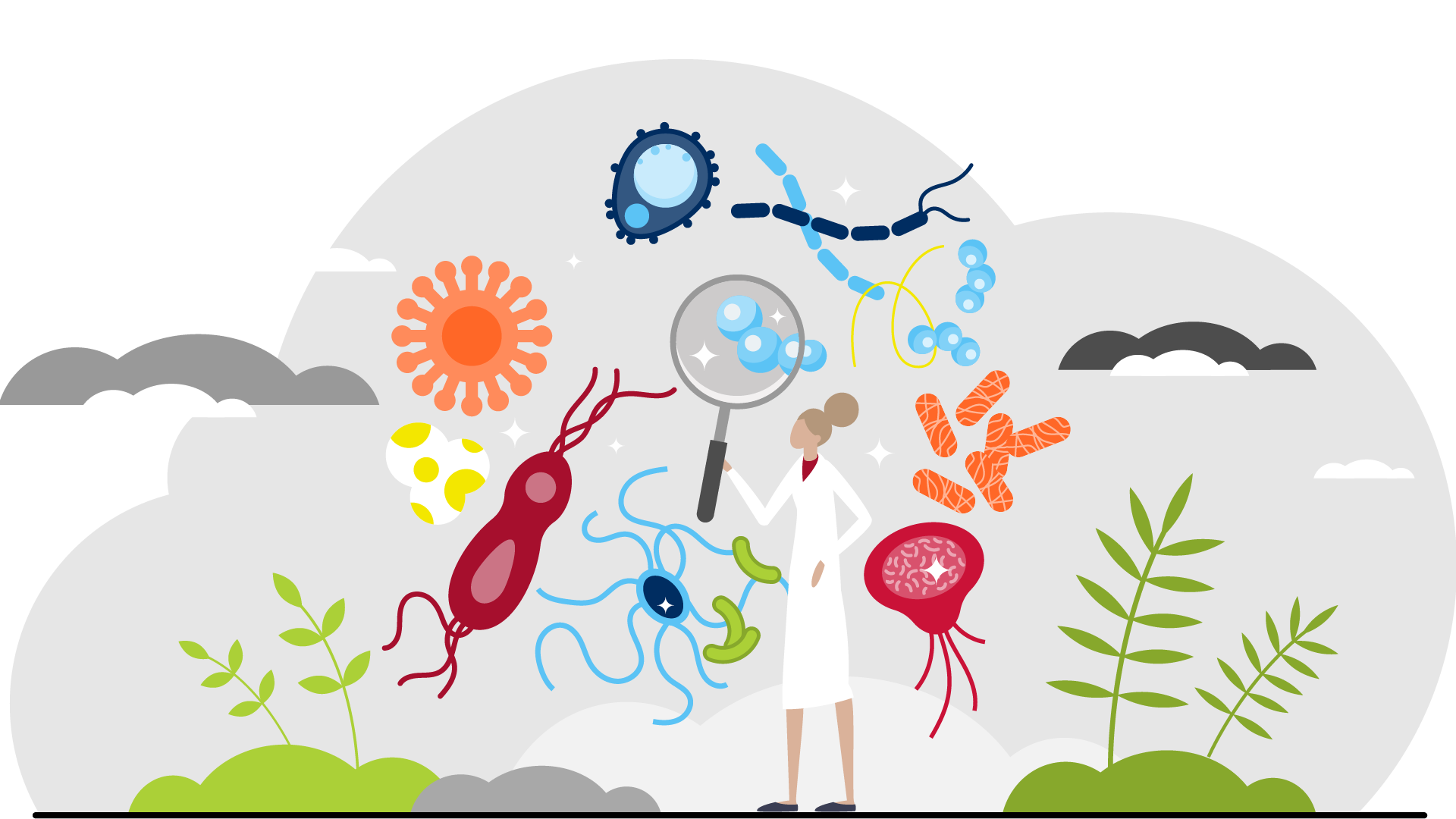Core objectives
-
Compare bacteria, viruses, fungi, and parasites by structure, reproduction, classification, and diagnostics.
-
Define pathogenesis and virulence.
-
Understand selective toxicity and its role in antimicrobial therapy.
Viruses
-
Acellular, require host for replication.
-
Genetic material: DNA or RNA (never both).
-
Capsid proteins, some have envelopes.
-
Intracellular pathogens diagnostic and treatment challenges.
-
Example: SARS-CoV-2 +ssRNA virus, uses ACE2 receptor.
Bacteria
-
Prokaryotes: no nucleus, 70S ribosomes.
-
Binary fission for reproduction.
-
Cell wall: Gram-positive vs. Gram-negative.
-
Classification: morphology, staining, 16S rRNA.
-
Targets for antibiotics: cell wall, ribosomes, DNA replication.
Fungi
-
Eukaryotes: nucleus, organelles, ergosterol in membrane.
-
Cell wall: Ergosterol, chitin, glucans.
-
Reproduction: Sexual and asexual.
-
Forms: Yeasts (unicellular), molds (hyphae).
-
Antifungal targets: Ergosterol, cell wall synthesis.
Parasites
-
Protozoa (unicellular) and helminths (multicellular).
-
Life cycles involve definitive, intermediate, and dead-end hosts.
-
Definitive host: The host in which the organism reaches sexual maturity and reproduces. Also called “primary host”
-
Intermediate host: The host in which the organism undergoes asexual multiplication/growth, e.g., host that harbors the larval stage of a parasite. Also called “secondary host.”
-
Dead-end host: A host that harbors the organism, but in which the parasite cannot complete it’s life-cycle. Also called “incidental” or “accidental” host.
-
-
Transmission: Ingestion, vector, skin penetration.
-
Examples: Giardia, Entamoeba, Plasmodium, Schistosoma, Scabies.
Pathogenesis and virulence
-
Virulence: Ability to cause disease.
-
Steps in infection: Attach, Persist, Invade, Adapt, Replicate, Exit/Spread.
-
Colonization ≠ infection.
-
Latency: Dormant state.
-
Immune evasion: Antigenic variation, immune suppression.
Diagnostics and treatment
-
Diagnostics vary by organism:
-
Viruses: PCR, antigen tests.
-
Bacteria: Culture, Gram stain.
-
Fungi: Microscopy, culture.
-
Parasites: Direct visualization with various types of microscopy.
-
-
Selective toxicity: Target pathogen without harming host.
-
Treatment: Antivirals, antibiotics, antifungals, antiparasitics.
Host response and prevention
-
Immune recognition varies by pathogen type, size, and location.
-
Portals of entry: Skin, respiratory, GI, GU, blood, placenta.
-
Healthcare-associated infections (HAIs): Pneumonia, UTI, bloodstream infections.
-
Prevention: Hand hygiene, PPE, environmental cleaning.
Infection control
-
Standard precautions: For all patients.
-
Transmission-based precautions: Based on specific pathogen, site of infection, mode of transmission.
-
Example: Contact, droplet, airborne
-
-
Primary prevention: Vaccines, chemoprophylaxis, sanitation.
Study strategy for each organism and disease
-
Organism
-
Key features
-
Classification
-
Virulence factors
-
-
Infectious disease
-
Clinical manifestations
-
Epidemiology
-
Pathophysiology
-
Diagnostics
-
Treatment
-
Prevention
-
Used Co-Pilot to draft a summary page and updated.
Learning goals
- Compare and contrast bacteria, viruses, fungi, and parasites in terms of structural features, reproductive strategies, basic methods of identification for diagnostic purposes, and common classification schemes
- Define pathogenesis and virulence (as it relates to microbes) and describe the role of the immune system in infectious disease
- Describe selective toxicity and how it relates to treatment of infections from microbes
Pre-session materials
Study materials
These materials are not required; they are supplementary to large group session. They are intended as a curated guide to content focused on the learning objectives. There are both textbook and video resources for this session for students to use per their preference. For each reference, I have designated the learning goal addressed with a and number.
Click the book icons below to go to the library resources listed.
-
Jawetz, Melnick, & Adelberg's Medical Microbiology, 28e
Chapter 1: The Science of Microbiology
1 Sections on Viruses, Prokaryotes, and Protists -
Sherris Medical Microbiology, 8e
Chapter 1: Infection—Basic Concepts
1 Infectious Agents: The Microbial World
This section provides the high level overview of microbial agents as an introduction with summary of basic features of bacteria, viruses, fungi, and parasites.
2 Infectious Diseases
This section covers some of the same topics as the RWJF videos but also has a brief overview of immune response to infection, pathogenesis, and brief conceptual introduction to mainstays of Clinical Infectious Diseases: Manifestations, Diagnosis, Treatment, and Prevention. -
Robert Wood Johnson Microbiology, Immunology, and Infectious Diseases
1 Introduction to Immunology Springboard
This is an overview in somewhat sad story-form of how the immune system functions in response to infectious disease (not the only role of the immune system!). You will spend a lot more time learning about the types of cells and how they work in dedicated immunology sessions, but this is a basic introduction to terminology used in microbiology-infectious diseases, such as antibodies, B-cells, and T-cells.
-
Compare and contrast table
1 Consider using this table to help compare and contrast the basic features of microorganisms
For now, focus on basic descriptions. We will dive deeper into the details of these features during future sessions.
|
Microorganism |
Cell wall |
Cell plan/cellular structures |
Metabolism |
Genetic material and arrangement |
|---|---|---|---|---|
|
Viruses
|
|
|
|
|
|
Bacteria
|
|
|
|
|
|
Fungi
|
|
|
|
|
|
Parasites
|
|
|
|
|

